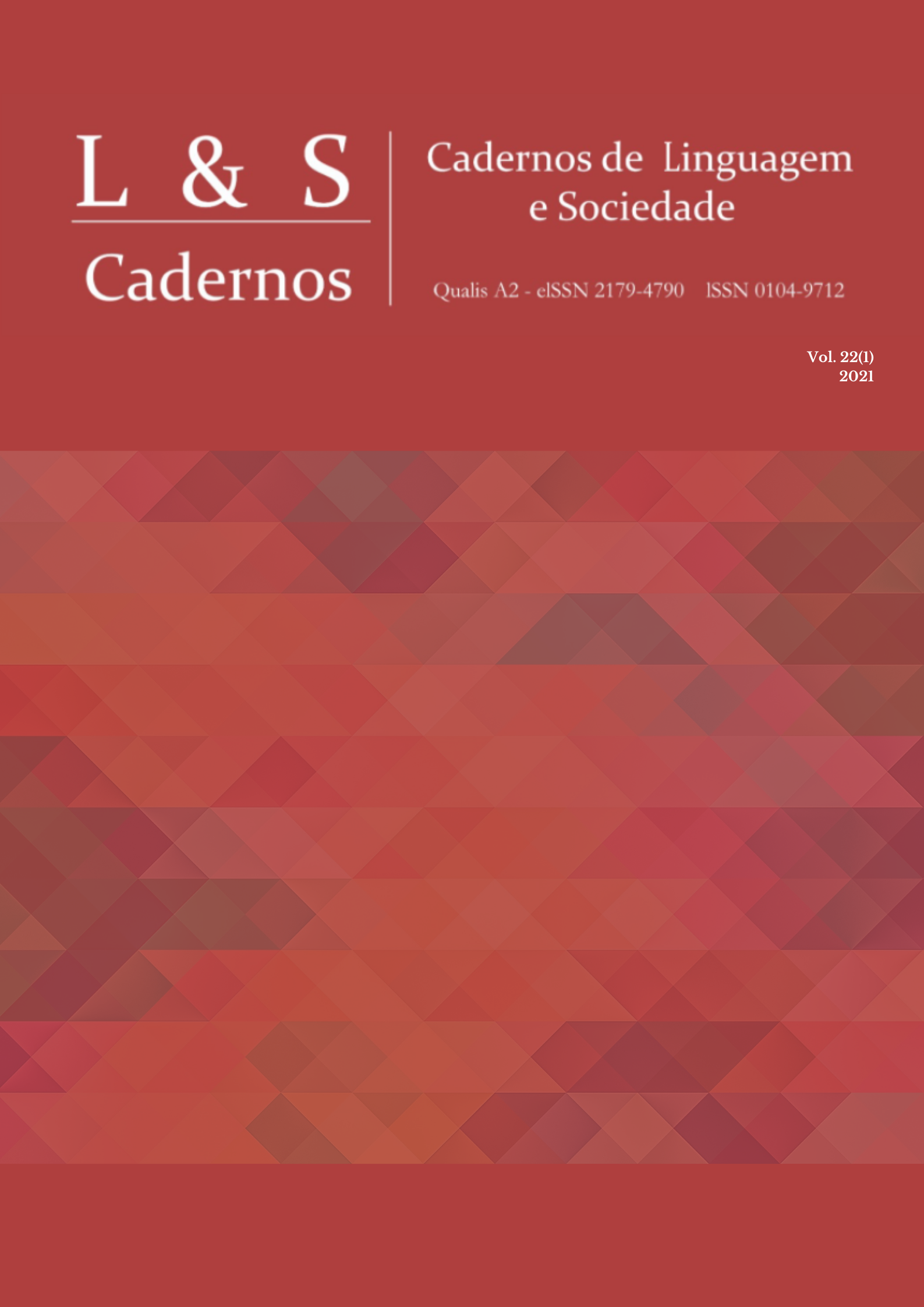Social Semiotics and meaning-making production in protective face masks against the new coronavirus
Keywords:
Social Semiotics, Multimodality, Semiotics of clothing, Protective face mask, CoronavirusAbstract
This paper investigates the protective face mask against the new coronavirus as a semiotic mode and a cultural artifact. Based on theoretical and methodological precepts of Social Semiotics and the Multimodal Discourse Approach (Hodge & Kress, 1988; Kress, 2006, 2010; Kress & Mavers, 2005; Kress & van Leeuwen, 2001, 2002, 2006), this study describes the socio-historical evolution of the face masks and analyzes how the process of meaning-making takes place in the light of the semiotics of clothing (Barthes 1980; Lynteris, 2020; Spooner,1967; Strassler &S chlich, 2020). We show that protective masks build up meanings, social identities, representations, values, worldviews in the articulation of materials and visual or verbal-visual motifs in their composition.
Downloads
References
ALVES, S. Há pessoas dizendo nas redes sociais que “quem crê em Deus não precisa das medidas de prevenção”; o que diz a Bíblia?. Blog do Silvério Alves, 3 de maio 2020. Disponível em: <https://bit.ly/2OCqoQr>. Acesso em: 18 jul. 2020.
ARCANJO, D. Na pandemia, máscaras com palavras de ordem fazem as vezes de cartazes em protestos. Folha de S.Paulo, 24 jun. 2020. Disponível em: <https://bit.ly/3gmnY3B>. Acesso em: 22 ago. 2020.
BARTHES, R. Sistema da moda. São Paulo: Companhia Editora Nacional; Edusp, 1980.
BARTHES, R. The language of fashion. London: Bloomsbury, 2005.
BERGAMO, M. Máscara é ‘coisa de viado’, dizia Bolsonaro na frente de visitas. Folha de S.Paulo, 7 jul. 2020. Disponível em: <https://bit.ly/2CPB1MQ>. Acessoem: 18 jul. 2020.
BLAKEMORE, E. Why plague doctors wore those strange beaked masks. NationalGeographic, 12 mar. 2020. Disponível em: <https://on.natgeo.com/3185COt>. Acessoem: 31 jul. 2020.
BURN, A. KRESS, G. Multimodality, style and the aesthetic: the case of the digital werewolf.In: TØNNESSEN, E. &F. FORSGREN (eds.)Multimodality and Aesthetics.New York: Routledge, 2018, p. 15-36.
CAMPBELL, C. When the meaning is not a message: a critique of the consumption as communication thesis. In: NAVA, M.; BLAKE, A.; MACRURY, I.; RICHARDS, B. (Eds.). Buy this book: studies in advertising and consumption. London: Routledge, 1997. p. 340-351.
CORRÊA, A. O que era a ‘Liga Anti-Máscara’, que protestava contra restrições na gripe espanhola. BBC News Brasil, 10 maio 2020. Disponível em: <https://bbc.in/30dMdMv>. Acesso em: 31 jul. 2020.
DIONISIO, A. P. Gêneros Textuais e Multimodalidade. In: KARWOSKI, A. M. ; GAYDECZKA, B. ; BRITO, K. S. (Org.) Gêneros textuais: reflexões e ensino. São Paulo: Parábola Editorial, 2011, p. 137-152.
DIONISIO, A.P.; VASCONCELOS, L. J. Multimodalidade, gênero textual e ensino. In: BUNZEN, C.; MENDONÇA, M. (Orgs.). Múltiplas linguagens para o ensino médio. São Paulo: Parábola, 2013. p. 19-42.
DIONISIO, A.P.; VASCONCELOS, L.J.; SOUZA, M.M. Multimodalidade e leituras: funcionamento cognitivo, recursos semióticos, convenções visuais. Recife: Pipa Comunicação, 2014.
GILMAN, C.P. The dress of women: a critical introduction to the symbolism and sociology of clothing. Westport: Greenwood, 2002.
GOMBRICH, E.H. História da arte. São Paulo: Círculo do Livro, 1972.
GUALBERTO, C.L. Apresentação. In: GUALBERTO, C.L. (Org.). Muito além das palavras: leituras multimodais a partir da Semiótica Social. São Paulo: Pimenta Cultural, 2017. p. 7-8.
GUALBERTO, C. L.; KRESS, G. Social Semiotics. In: HOBBS, R.; MIHAILIDIS, P. (Org.). The International Encyclopedia of Media Literacy. Hoboken: Wiley, 2019, p. 1-9.
HALLIDAY, M.A.K. Language as social semiotic: the social interpretation of language and meaning. London: Edward Arnold, 1978.
HODGE, R.; KRESS, G. Language as ideology. London: Routledge, 1979.
HODGE, R.; KRESS, G. Social Semiotics. Cambridge: Polity Press, 1988.
JOBLING, P. Fashion spreads: word and image in fashion photography since 1980. Oxford: Berg, 1999.
JUCÁ, B. “Máscara ideológica” e outras contradições de um Ministério da Saúde militarizado. El País, 13 jul. 2020. Disponível em: <https://bit.ly/2WtQeub>. Acesso em: 18 jul. 2020.
KRESS, G. Before writing: rethinking the paths to literacy. London: Routledge, 1997.
KRESS, G. Multimodality: a social semiotic approach to contemporary communication. London: Routledge, 2010.
KRESS, G.; MAVERS, D. Social Semiotics and multimodal texts. In: SOMEKH, B.; LEWIN, C. (Eds.). Research methods in the Social Sciences. London: Sage, 2005. p. 172-179.
KRESS, G.; VAN LEEUWEN, T. Colour as a semiotic mode: notes for a grammar of colour. Visual Communication, v. 1, n. 3, p. 343-368, 2002.
KRESS, G.; VAN LEEUWEN, T. Multimodal discourse: the modes and media of contemporary communication. London: Arnold, 2001.
KRESS, G.; VAN LEEUWEN, T. Reading images: the grammar of visual design. 2.ed. London: Routledge, 2006.
LIMA, J.D. Por que homens tendem a resistir mais ao uso de máscara. Nexo, 24 jun. 2020. Disponível em: <https://bit.ly/2ZEHGmc>. Acesso em: 18 jul. 2020.
LYNTERIS, C. Plague masks: the visual emergence of anti-epidemic personal protection equipment. Medical Anthropology, v. 37, n. 6, p. 442-457, 2018.
MARTIN, A. The history behind Japan’s love of face masks. The Japan Times, 4 jul. 2020. Disponível em: <https://bit.ly/3fjhNwG>. Acesso em: 31 jul. 2020.
MORAES, S.F. Um drama que se repete. Debate News, 5 abr. 2020. Disponível em: <https://bit.ly/39KaXPN>. Acesso em: 31 jul. 2020.
NASH, S.E. The masked man. Sapiens, 29 abr. 2020. Disponível em: <https://bit.ly/2PdFxYF>. Acesso em: 31 jul. 2020.
ORGANIZAÇÃO MUNDIAL DA SAÚDE (OMS); ORGANIZAÇÃO PAN-AMERICANA DA SAÚDE (OPAS). Orientação sobre o uso de máscaras no contexto da COVID-19. Iris – Repositório Institucional para Troca de Informações, 5 jul. 2020. Disponível em: <https://bit.ly/3fURtdH>. Acesso em: 18 jul. 2020.
POSTREL, V. Pandemics come and go but medical masks are eternal. Bloomberg, 10 abr. 2020. Disponível em: <https://bloom.bg/31398tp>. Acesso em: 31 jul. 2020.
SPOONER, J.L. History of surgical face masks: the myths, the masks, and the men and women behind them. Aorn Journal, v. 5, n.1, p. 76-80, jan. 1967. Disponível em: <https://bit.ly/3hRelLy>. Acesso em: 31 jul. 2020.
STRASSER, B.J.; SCHLICH, T. The art of medicine: a history of the medical mask and the rise of throwaway culture.The Lancet, v. 396, p. 19-20, jul. 2020.
TITO, F. Coronavírus: arte reflete impacto mundial da doença. G1, 19 mar. 2020. Disponível em: <https://glo.bo/2QfLHb0>. Acesso em: 22 ago. 2020.
VALFRÉ, V. Religiosos formam rede de desinformação sobre covid-19. O Estado de S.Paulo, 18 jul. 2020. Disponível em: <https://bit.ly/2DW4aqh>. Acessoem: 18 jul. 2020.
VAN LEEUWEN, T. The critical analysis of musical discourse. Critical Discourse Studies, v. 9, n.4, p. 319-328, 2012.
VAN LEEUWEN, T. Towards a semiotics of typography. Information Design Journal, v. 14, n. 2, p.139-155, 2006.
WILSON, M. 28 of the most creative face masks from around the world. Insider, 17 jul. 2020. Disponível em: <https://bit.ly/2QjBGKc>. Acesso em: 23 ago. 2020.
WINGERT, P.S. Mask. Encyclopedia Britannica, 10 fev. 2020. Disponível em: <https://bit.ly/2CWQ48d>. Acesso em: 31 jul. 2020.
YUQIAO, J. The evolution of face masks. Global Times, 12 fev. 2020. Disponível em: <https://bit.ly/39PzhQo>. Acesso em: 31 jul. 2020.
Downloads
Published
Issue
Section
License
Copyright (c) 2021 Cadernos de Linguagem e Sociedade do Programa de Pós-Graduação em Linguística da UnB é licenciado sob uma Licença Creative Commons Atribuição-Uso não-comercial-Vedada a criação de obras derivadas 3.0 Unported.

This work is licensed under a Creative Commons Attribution 4.0 International License.



